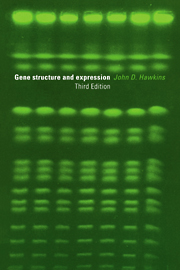Book contents
- Frontmatter
- Contents
- Introduction to the third edition
- Introduction to the second edition
- Introduction to the first edition
- List of abbreviations
- 1 Deoxyribonucleic acid (DNA)
- 2 Ribonucleic acid (RNA)
- 3 Methodology
- 4 Prokaryotic DNA replication and gene expression
- 5 The operon concept
- 6 Eukaryotic gene organisation and replication
- 7 Eukaryotic transcription
- 8 Post-transcriptional processing of RNA
- 9 Oncogenes
- 10 Haemoglobin
- 11 Proteins of the immune system
- 12 Some gene families
- 13 Mitochondrial and chloroplast genomes
- 14 Different and evolving genomes
- Glossary
- Reading lists
- Index
11 - Proteins of the immune system
Published online by Cambridge University Press: 05 June 2012
- Frontmatter
- Contents
- Introduction to the third edition
- Introduction to the second edition
- Introduction to the first edition
- List of abbreviations
- 1 Deoxyribonucleic acid (DNA)
- 2 Ribonucleic acid (RNA)
- 3 Methodology
- 4 Prokaryotic DNA replication and gene expression
- 5 The operon concept
- 6 Eukaryotic gene organisation and replication
- 7 Eukaryotic transcription
- 8 Post-transcriptional processing of RNA
- 9 Oncogenes
- 10 Haemoglobin
- 11 Proteins of the immune system
- 12 Some gene families
- 13 Mitochondrial and chloroplast genomes
- 14 Different and evolving genomes
- Glossary
- Reading lists
- Index
Summary
Immunoglobulins consist of H and L chains
Immunoglobulins (Igs), which are antibodies, are proteins consisting of four polypeptide chains – two identical light (L) chains of about 220 amino acid residues, and two identical heavy (H) chains containing between 450 and 600 amino acid residues. Each L chain consists of two domains of approximately equal size. The N-terminal domain is variable in amino acid sequence, and is different in each individual L chain that has so far been sequenced. The C-terminal domain is constant in sequence, though there are two types that exhibit a high degree of homology, known as κ and λ. Either one, but not both, may occur in one Ig molecule.
The H chains contain four or five domains, each with about 110 residues. Again, the N-terminal domain is variable in sequence, and together with the N-terminal variable domain of the L chain forms one of the two antigenbinding sites in each molecule (Fig. 11.1). The hinge region, between the second and third domains, generally contains about 20 amino acid residues, and is devoid of secondary structure and therefore very flexible. There are five types of H chain – α, γ, δ, ∊, μ – whose constant portions are quite distinct, though homologous. ∊ and μ have an extra domain. There are subclasses of α- and γ-chains. Intact Ig molecules are identified by suffixes of Latin letters corresponding to the Greek letter of the H chain (A, G, D, E, M).
- Type
- Chapter
- Information
- Gene Structure and Expression , pp. 141 - 158Publisher: Cambridge University PressPrint publication year: 1996



